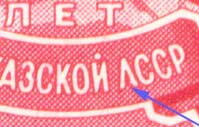Stamp: Arms and Symbols of Abkhasian ASSR (Soviet Union, USSR 1971)
Arms and Symbols of Abkhasian ASSR (Soviet Union, USSR 1971)
03 March (Soviet Union, USSR ) within release 50th Anniversary of Autonomous SSR goes into circulation Stamp Arms and Symbols of Abkhasian ASSR face value 4 Russian kopek
| Stamp Arms and Symbols of Abkhasian ASSR in catalogues | |
|---|---|
| Michel: | Mi: SU 3856I |
| Soloviev: | Sol: SU 3970K |
Stamp is vertical format.
Plate flaw: Letter "Л" in lieu of "А" (pos. 7).Also in the issue 50th Anniversary of Autonomous SSR:
- Stamp - Arms and symbols of agriculture and industry of Abkhasian re face value 4;
- Stamp - Arms and Symbols of Abkhasian ASSR face value 4;
- Stamp - Arms and Symbols of Abkhasian ASSR face value 4;
Stamp Arms and Symbols of Abkhasian ASSR it reflects the thematic directions:
An anniversary is the date on which an event took place or an institution was founded in a previous year, and may also refer to the commemoration or celebration of that event. For example, the first event is the initial occurrence or, if planned, the inaugural of the event. One year later would be the first anniversary of that event. The word was first used for Catholic feasts to commemorate saints. Most countries celebrate national anniversaries, typically called national days. These could be the date of independence of the nation or the adoption of a new constitution or form of government. The important dates in a sitting monarch's reign may also be commemorated, an event often referred to as a "Jubilee".
A coat of arms is an heraldic visual design on an escutcheon (i.e. shield), surcoat, or tabard. The coat of arms on an escutcheon forms the central element of the full heraldic achievement which in its whole consists of shield, supporters, crest, and motto. A coat of arms is traditionally unique to an individual person, family (except in the United Kingdom), state, organisation or corporation.
A symbol is a mark, sign, or word that indicates, signifies, or is understood as representing an idea, object, or relationship. Symbols allow people to go beyond what is known or seen by creating linkages between otherwise very different concepts and experiences. All communication (and data processing) is achieved through the use of symbols. Symbols take the form of words, sounds, gestures, ideas, or visual images and are used to convey other ideas and beliefs. For example, a red octagon is a common symbol for "STOP"; on maps, blue lines often represent rivers; and a red rose often symbolizes love and compassion. Numerals are symbols for numbers; letters of an alphabet may be symbols for certain phonemes; and personal names are symbols representing individuals.



